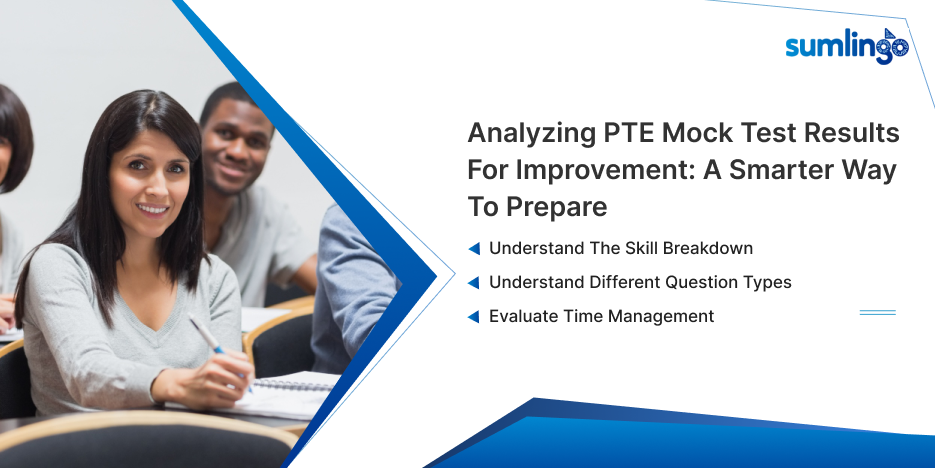Preparing for the Pearson Test of English (PTE) involves more than just consistent practice. it’s about strategic learning and continuous improvement.However, simply taking mock tests isn’t enough.
1. Understand the Skill Breakdown
Most mock test platforms provide an overall score along with section-wise scores: Speaking, Writing, Reading, and Listening. While your total score is important, it’s the detailed breakdown that tells the real story.
Start by:
- Reviewing your score report carefully after each mock test.
- Identifying strengths and weaknesses across all four skill areas.
- Analyzing mistakes and improving them by going back to questions you answered incorrectly and understanding why. This could be due to lack of understanding, misinterpretation, or timing issues.
Focus on:
- Which sections are consistently strong?
- Which ones show inconsistent performance?
- Trends over multiple mock tests
For example, you might notice that while your Reading scores are stable, your Speaking section fluctuates. That could be a sign of nervousness, unclear pronunciation, or lack of fluency. Recognizing these patterns early allows you to target those weaknesses directly.
Are you ready to test your skills?
2. Understand Different Question Types
Each PTE section includes various task types, and every candidate has different strengths. An effective analysis involves identifying specific tasks where you’re losing marks.
For example:
- In the Speaking section, are you underperforming in Repeat Sentence or Describe Image?
- In Writing, is your score lower in Summarize Written Text compared to Write Essay?
- In Reading, are reordered paragraphs your weak spot?
- In Listening, are you consistently missing out on Write from Dictation or Highlight Incorrect Words?
Breaking performance down by task type helps you focus your practice sessions more efficiently instead of revisiting entire sections unnecessarily.
3. Evaluate Time Management
PTE mock test results often indicate how much time you spent per question or task. Analyze this data to understand:
- Are you rushing through easier tasks and spending too long on harder ones?
- Are you consistently missing the last few questions in a section?
Improving time management is often a quick win. With better pacing, many candidates find they can significantly raise their scores without increasing study time just by optimizing their test-taking strategy.
Are you ready to test your skills?
4. Assess Accuracy vs. Fluency (Especially in Speaking)
The Speaking section is assessed on pronunciation, fluency, and content. If your content is strong but your fluency score is low, it could mean you need more speaking practice under timed conditions.
Analyze:
- Are you hesitating or pausing often?
- Do you speak too fast, causing mispronunciations?
- Are you using filler words like “um” or “uh”?
Use AI-scored mock platforms like Sumlingo, which give detailed feedback on fluency, intonation, and pronunciation to fine-tune your speaking performance.
5. Review Writing for Grammar, Structure, and Vocabulary
In writing tasks, high scores depend on more than just answering the prompt. You must demonstrate:
- Strong grammar
- Logical structure
- Varied and academic vocabulary
After each mock test, go back and critically review your written responses. Look for repetitive words, awkward phrasing, or structural issues. If possible, compare them to high-scoring sample answers or use platforms that provide feedback and corrections, like SumlingoPractice.
6. Track Progress Over Time
Don’t rely on a single mock test to judge your preparedness. Take multiple mock tests over weeks and compare your results. Look for consistent improvement in:
- Sectional scores
- Time management
- Fluency and accuracy
- Confidence and comfort level with the format
Plotting your scores on a progress chart can provide motivation and a clear sense of direction.
Are you ready to test your skills?
7. Set Targeted Goals After Each Test
Each mock test analysis should end with a short action plan. For example:
- Focus on improving the Repeat Sentence by shadowing native speakers for 10 minutes daily.
- Practice Write From Dictation exercises daily.
- Try to complete the essay within 20 minutes.
Set 1–3 specific, actionable goals after each test and track whether those changes lead to improvements in the next mock.
8. Use OnlinePlatforms Like Sumlingo
Platforms like Sumlingo not only provide real-time mock tests but also offer deep insights with AI-
powered feedback. From detailed scoring to pronunciation analysis and grammar checks, the software gives you everything you need to turn raw scores into meaningful learning.
Its personalized dashboards help you identify weak areas, track trends, and even suggest custom exercises tailored to your performance history, making your preparation more strategic and efficient.









